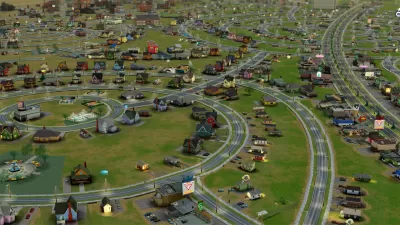In New Mexico, construction will begin this summer on a fully functioning 15-square mile new town, designed "to test everything about the future of smart cities, from autonomous cars to new wireless networks," reports Emily Badger.
The Center for Innovation, Testing and Evaluation (CITE), being built by Pegasus Global Holdings in the Southeastern corner of New Mexico, just outside of Hobbs, will be modeled on a mid-American town of 35,000 people and "will have functioning roads, self-sustaining utilities, and its own communications infrastructure," but it will be home to no one.
Badger provides the details on the plan for the city, which is intended to "address one of the great obstacles to the commercialization of new
technology: that "valley of death" between early-stage R&D and the
deep pockets that are willing to invest in products once they have hard
data behind them," and the real-world town it is being modeled after.
"A small city will grow up along a pattern familiar to
any urban planner with historic warehouses, a low-rise urban center of
four- to six-story buildings, light industrial and retail zones,
residential neighborhoods, inner-ring "streetcar" suburbs, exurbs, and a
rural area. There will be gas stations and big-box stores,
cottage-style housing, and split-level homes. And flushing toilets. 'Everybody seems to be fixated on the flushing toilets,' [Bob] Brumley [with Pegasus] says.
Pegasus will stop shy of interior decorating. But these structures will
otherwise be built to code and move-in ready. The whole idea, after all,
is to replicate true-to-life cities--at least as true-to-life as cities
can be without any residents around."
"Pegasus designed CITE's layout using Census data on the profile of
typical cities this size. In the midst of developing the project,
Brumley flew into the Charlotte airport and caught a glimpse out the
window of a place that looked from above exactly like what he had been
envisioning. Since then, Rock Hill, South Carolina, has served as the
more literal model for the mock town that will develop outside of Hobbs."
FULL STORY: America's Most Innovative Neighborhood: 15 Square Miles In New Mexico, Population: 0

Maui's Vacation Rental Debate Turns Ugly
Verbal attacks, misinformation campaigns and fistfights plague a high-stakes debate to convert thousands of vacation rentals into long-term housing.

Planetizen Federal Action Tracker
A weekly monitor of how Trump’s orders and actions are impacting planners and planning in America.

In Urban Planning, AI Prompting Could be the New Design Thinking
Creativity has long been key to great urban design. What if we see AI as our new creative partner?

King County Supportive Housing Program Offers Hope for Unhoused Residents
The county is taking a ‘Housing First’ approach that prioritizes getting people into housing, then offering wraparound supportive services.

Researchers Use AI to Get Clearer Picture of US Housing
Analysts are using artificial intelligence to supercharge their research by allowing them to comb through data faster. Though these AI tools can be error prone, they save time and housing researchers are optimistic about the future.

Making Shared Micromobility More Inclusive
Cities and shared mobility system operators can do more to include people with disabilities in planning and operations, per a new report.
Urban Design for Planners 1: Software Tools
This six-course series explores essential urban design concepts using open source software and equips planners with the tools they need to participate fully in the urban design process.
Planning for Universal Design
Learn the tools for implementing Universal Design in planning regulations.
planning NEXT
Appalachian Highlands Housing Partners
Mpact (founded as Rail~Volution)
City of Camden Redevelopment Agency
City of Astoria
City of Portland
City of Laramie





























